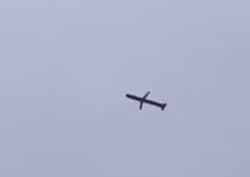On March 8, the Russian Kh-101 strategic air-to-ground cruise missile was spotted flying over Ukraine.
Such cruise missiles are very useful to strike at targets deep into enemy territory without threat to the launch platform. The bombers do not have to penetrate enemy airspace to any great extent.
According to open sources, the maximum range of Kh-101 is 5500 km (3418 miles), it has a cruise speed of 700-720 km/h, a maximum speed of 970 km/h, and an endurance of flight of 10 hours.
The mass of the warhead is usually about 400 kilograms, the power of the nuclear warhead is about 250 kilotons. The missile can be equipped with high-explosive, penetrating, or cluster warhead.
The first Kh-101s were armed with Tu-95 and Tu-160 bombers in the early 2010s. Today it can be launched by the Russian Tu-160 (twelve missiles), Tu-95MS16 (eight missiles), Tu-22M3/5 (four missiles) and Su-34 (two missiles) bombers.
The Raduga Kh-102 is another version of the missile fitted with a nuclear warhead.
The new weapon was first fire-tested in Syria on November, 17, 2015.
The Kh-101 missile has very high accuracy, the expected deviation from the target is only about ten meters. The equipment of carrier aircraft now allows to re-target the rocket even after its launch. Another feature of the Kh-101 is its low visibility, due to its special aerodynamic shape and special radio-absorbing materials.
Russia has actively worked out the use of these missile systems in Syria. A number of Western experts have expressed doubts about the effectiveness of these Russian missile systems. The successful experience of their use in Syria and now in Ukraine refutes these doubts.






